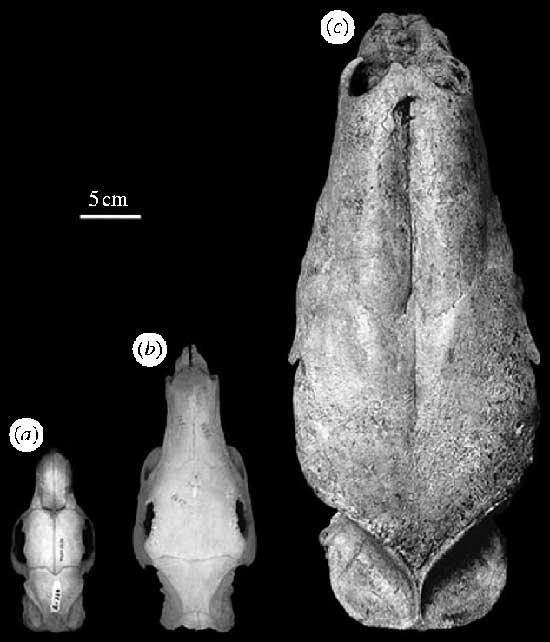The largest fossil rodent Authors
Andrés Rinderknecht (1), R. Ernesto Blanco (2)
(1) Museo Nacional de Historia Natural y Antropología, Montevideo 11300, Uruguay
(2) Facultad de Ingeniería, Instituto de Física, Julio Herrera y Reissig 565, Montevideo 11300, Uruguay
1. Introduction
The discovery of an exceptionally well-preserved skull permits the description of the new South American fossil species of the rodent, Josephoartigasia monesi sp. nov. (family: Dinomyidae; Rodentia: Hystricognathi: Caviomorpha). This species with estimated body mass of nearly 1000kg is the largest yet recorded. The skull sheds new light on the anatomy of the extinct giant rodents of the Dinomyidae, which are known mostly from isolated teeth and incomplete mandible remains. The fossil derives from San José Formation, Uruguay, usually assigned to the Pliocene-Pleistocene (4-2Myr ago), and the proposed palaeoenvironment where this rodent lived was characterized as an estuarine or deltaic system with forest communities.
2. Etymology
Josephoartigasia monesi dedicated to the palaeontologist Álvaro Mones for his studies on South American rodents.
3. Holotype
MNHN 921 (Museo Nacional de Historia Natural y Antropología, Montevideo, Uruguay): almost complete skull without left zygomatic arch, right incisor, left M2 and right P4-M1.

Skulls (dorsal view) of (a) D. branickii, (b) H. hydrochaeris and (c) J. monesi.
4. Age and locality
Uruguay, Departament of San José, coast of Río de La Plata, 'Kiyú' beach (34°44'S-56°50'W). The specimen was found in a boulder broken off from the San José Formation. It is composed of siltstone, claystones, medium-grained psammites and medium-to-conglomeratic psammites, with siltstone intercalations.
The largest fossil rodent. The discovery of an exceptionally well-preserved skull permits the description of the new South American fossilScience news |